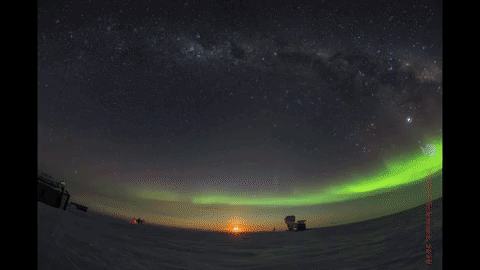Apr 19 2021
Astronomers are finding ways for smart alternatives to keep answering basic questions in physics after experiencing the devastating loss of the Arecibo Observatory in Puerto Rico and the usually prohibitive cost of satellite missions.
 The night sky dances with auroras over Dark Sector Laboratory at the Amundsen-Scott South Pole Station at the geographic South Pole. On the very far right, inside the silver ground shield, is BICEP3, which has been observing since 2016. The BICEP/Keck collaboration operates a series of small aperture telescopes including BICEP3 that are targeted at the search for signatures of inflationary gravitational waves. Image Credit: Robert Schwarz.
The night sky dances with auroras over Dark Sector Laboratory at the Amundsen-Scott South Pole Station at the geographic South Pole. On the very far right, inside the silver ground shield, is BICEP3, which has been observing since 2016. The BICEP/Keck collaboration operates a series of small aperture telescopes including BICEP3 that are targeted at the search for signatures of inflationary gravitational waves. Image Credit: Robert Schwarz.
During the 2021 APS April Meeting, at a press conference, they will disclose a new approach throughout both hemispheres for throwing light on dark matter and gravitational waves.
Shining the Oldest Light in the Universe on Dark Matter
A robust set of telescopes at the South Pole could serve a new function: investigation of the nature of dark matter and the history of stars.
Only satellites have the potential to perform surveys of the entire sky, whereas Earth-based telescopes can spend several years collecting a lot of information on tiny patches.
The BICEP/Keck array was developed as the world’s most sensitive detector of the polarization of medium-to-large sky features. From Antarctica, the array explores small regions of the Big Bang’s afterglow for primordial gravitational waves.
Together with the BICEP/Keck group, Cyndia Yu, a graduate student at Stanford University, has been investigating the chances that the very same telescopes could elevate the length of their scans, thereby capturing much bigger regions.
We are appreciating more and more the promise of moving away from detecting extremely faint signals on a small area, to looking for features on a larger sky patch.
Cyndia Yu, Graduate Student, Stanford University
The unconventional method has provided encouraging preliminary results. The first performance of trial scans will be shared by Yu, who will predict how sensitive the telescopes will be to targets such as WIMP annihilations and axion-like dark matter candidates.
Satellite missions are very rare and expensive, so any chance we get to make more measurements from ground-based programs is very exciting.
Cyndia Yu, Graduate Student, Stanford University
Catching the Wake of Supermassive Black Holes
Galaxy-sized detectors present in the northern hemisphere are exploring gravitational waves of very low frequency from the biggest black holes in the universe.
“In some ways, these arrays are like the LIGO detector,” stated Megan DeCesar, Senior Research Scientist at George Mason University, mentioning about the observatory that initially detected gravitational waves from other kinds of smaller black holes.
While LIGO uses lasers on Earth, pulsar timing arrays use steady pulses of radio waves from small, dense, rapidly rotating stars called pulsars that are located thousands of light years from Earth.
Megan DeCesar, Senior Research Scientist, George Mason University
DeCesar and the North American Nanohertz Observatory for Gravitational Waves collaboration examined over 12 years of pulsar data.
Recently, they reported a signal that might be considered as the first clue of a gravitational wave background, and which was more powerful than predicted using earlier data.
If this signal is confirmed as a gravitational wave signal, it would imply the finding of gravitational waves generated from several double-black-hole systems, each of which will ultimately combine to develop even bigger single black holes.
Arecibo has a major role in the NANOGrav observations. Its failure in December was a huge blow to the collaboration. However, increased observations at Green Bank and other facilities enabled NANOGrav to be on track to identify gravitational waves with many more years of data.
DeCesar will debate about how existing telescopes in New Mexico, West Virginia, and British Columbia, as well as future sensitive radio arrays, will enable NANOGrav to fulfill its gravitational-wave science targets.
Source: https://www.aps.org/